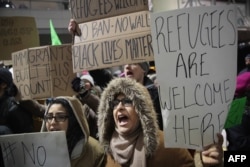Legal experts almost all agree that the constitutionality of President Donald Trump’s executive order temporarily halting travel to the U.S. by refugees and others from seven Muslim majority countries will end up being decided in the Supreme Court.
Numerous cases involving the travel ban are now working their way up through the courts, and one already seems destined for the nation's highest court. Here's how the U.S. courts may end up deciding whether President Trump's travel ban will stand.
Case path
The U.S. court system is like a pyramid. At the bottom level are 94 trial courts called district courts. If one person or entity wants to hold another to account, this is the place to start.
In the middle are the 13 U.S. courts of appeals. If one side or the other does not like the outcome at the district court level, they have recourse here.
At the top, all by itself, is the Supreme Court, the last court of appeal. All Supreme Court decisions are final.
District courts
There is at least one district court in each state and the District of Columbia. These courts resolve disputes by determining the facts and applying legal principles to decide who is right.
Numerous suits were filed against the travel ban in district court. The Civil Rights Litigation Clearing House has recorded 60 of them, some 20 of which have been already dismissed. Most of the suits were brought on behalf of individuals or groups of individuals, who were not admitted to the U.S. under the executive order.
They claim that their civil rights, such as due process and equal protection under the law, have been violated. They also claim that the constitutionally guaranteed freedom of religion has been abrogated because only Muslims were included in the order.
District court suits also were brought by multiple states. On January 29, two days after the order was signed, a New York District Court judge put a seven-day stay on deportations nationwide. On February 6, a judge in Washington State blocked the entire executive order, allowing both refugees and people from the seven banned countries to resume flying to the U.S.
Appeals courts
The appellate court’s task is to determine whether the law was applied correctly in the trial court. Appeals courts consist of three judges and do not use a jury. They review the procedures and the decisions in the trial court to make sure that the proceedings were fair and that the proper law was applied correctly.
Lawyers for the Trump administration went to the Ninth Circuit Court of Appeals, asking the higher court to overrule the Washington State judge and reinstate the travel order. The Department of Justice attorneys argue that the president has broad based power to determine who may come into the country and that he is “largely immune from judicial control.” Trump says the order is necessary to protect Americans from terrorists.
The states of Washington and Minnesota say the ban hurts their economic interests and would “unleash chaos again.”
On Sunday, the appellate court refused to immediately lift the stay, pending a review of the case. Ten former high-ranking diplomatic and national security officials, almost 100 tech companies, 280 law professors, and a number of civil liberties organizations filed in support of the suit.
The three judge panel will hear oral arguments in the case Tuesday, and a decision could come soon after.
Supreme court
No matter which side wins at the appeals level, the loser is likely to take the case one step higher – to the Supreme Court.
The normally nine justices on the Supreme Court do not take all the cases that are appealed to them. They pick and choose, although the justices are likely to take on this travel ban.
After the death of Justice Antonin Scalia in February 2016, the court is currently one justice short. This raises the specter of a possible tie. If the court is unable to muster a 5-3 majority, the case reverts back to the appeals court ruling.











